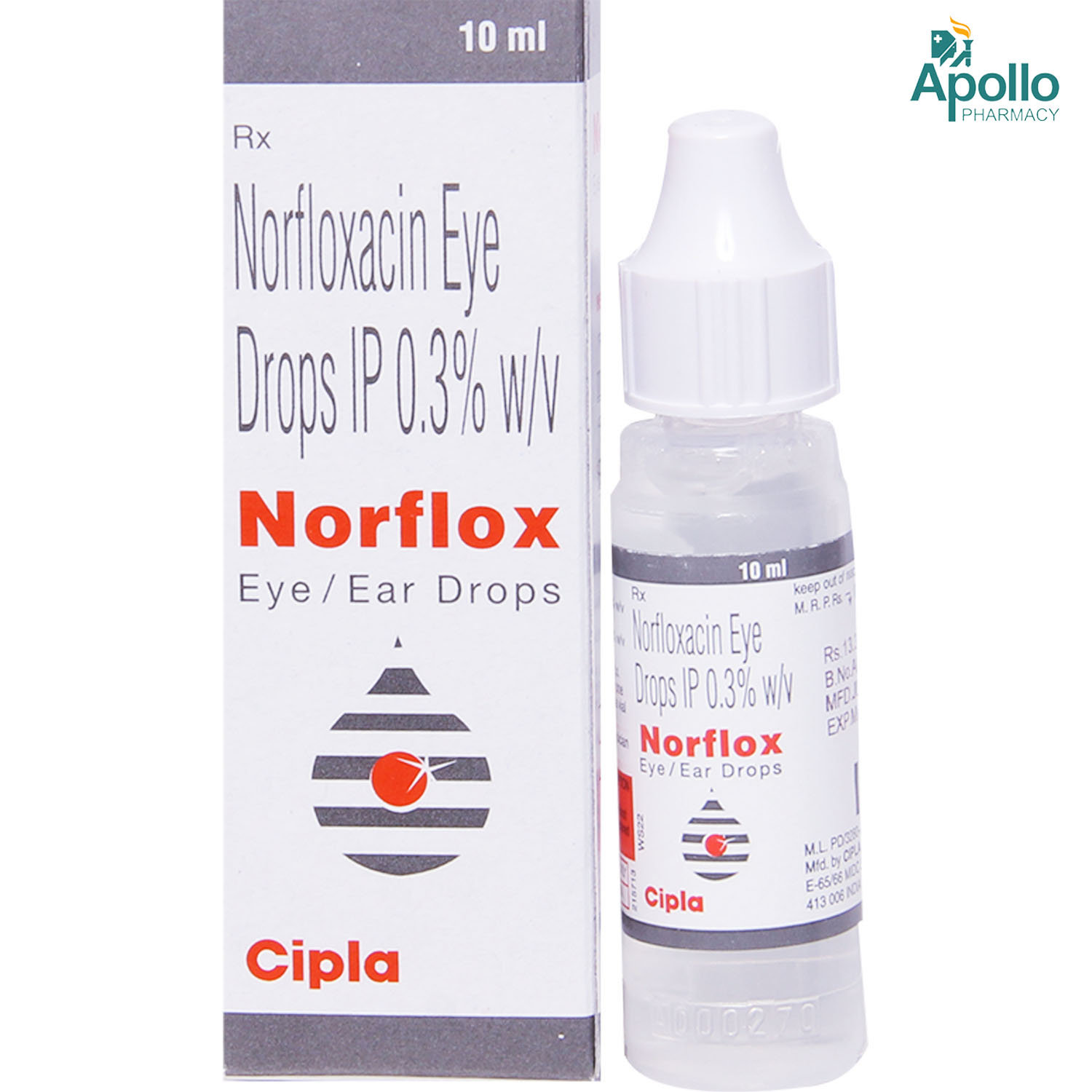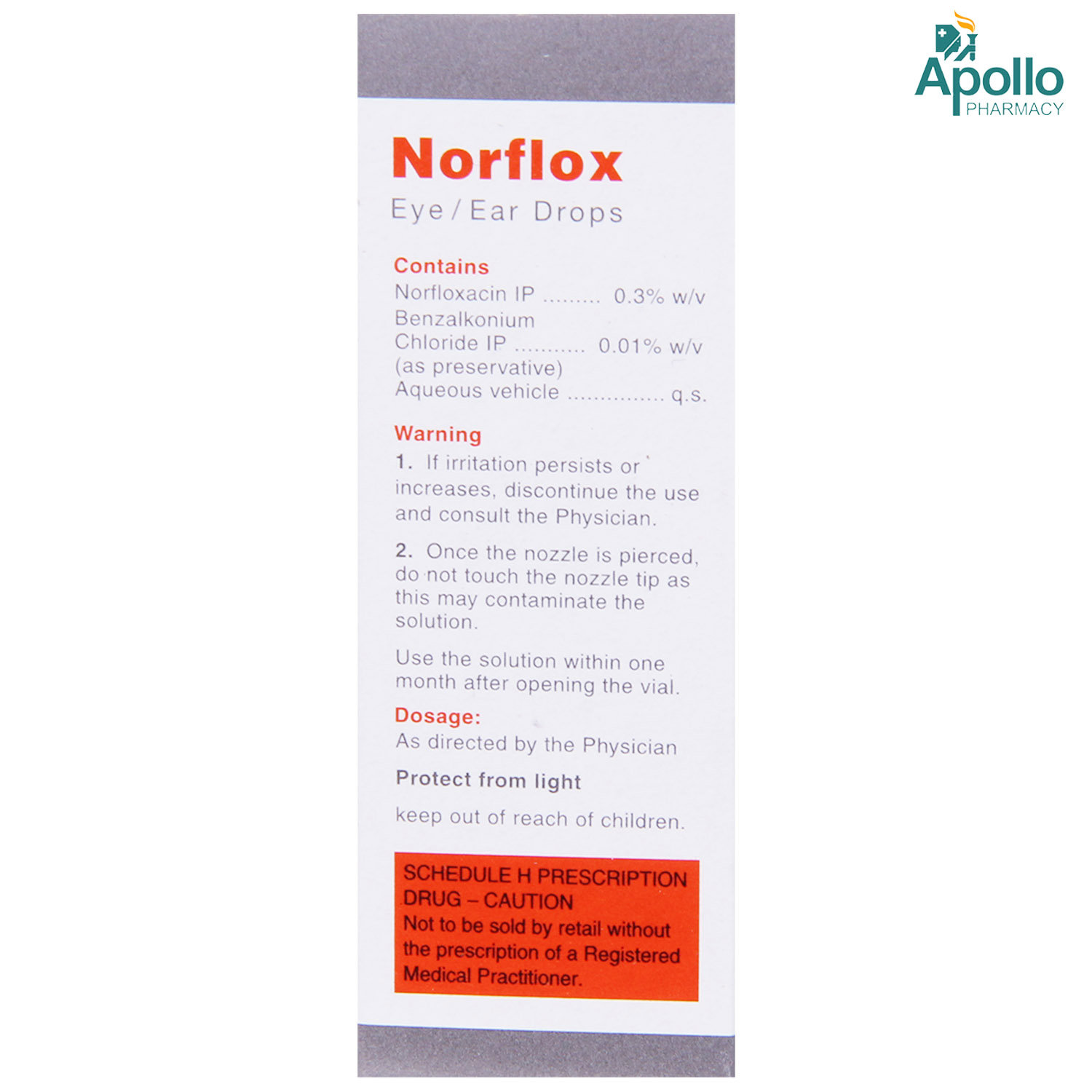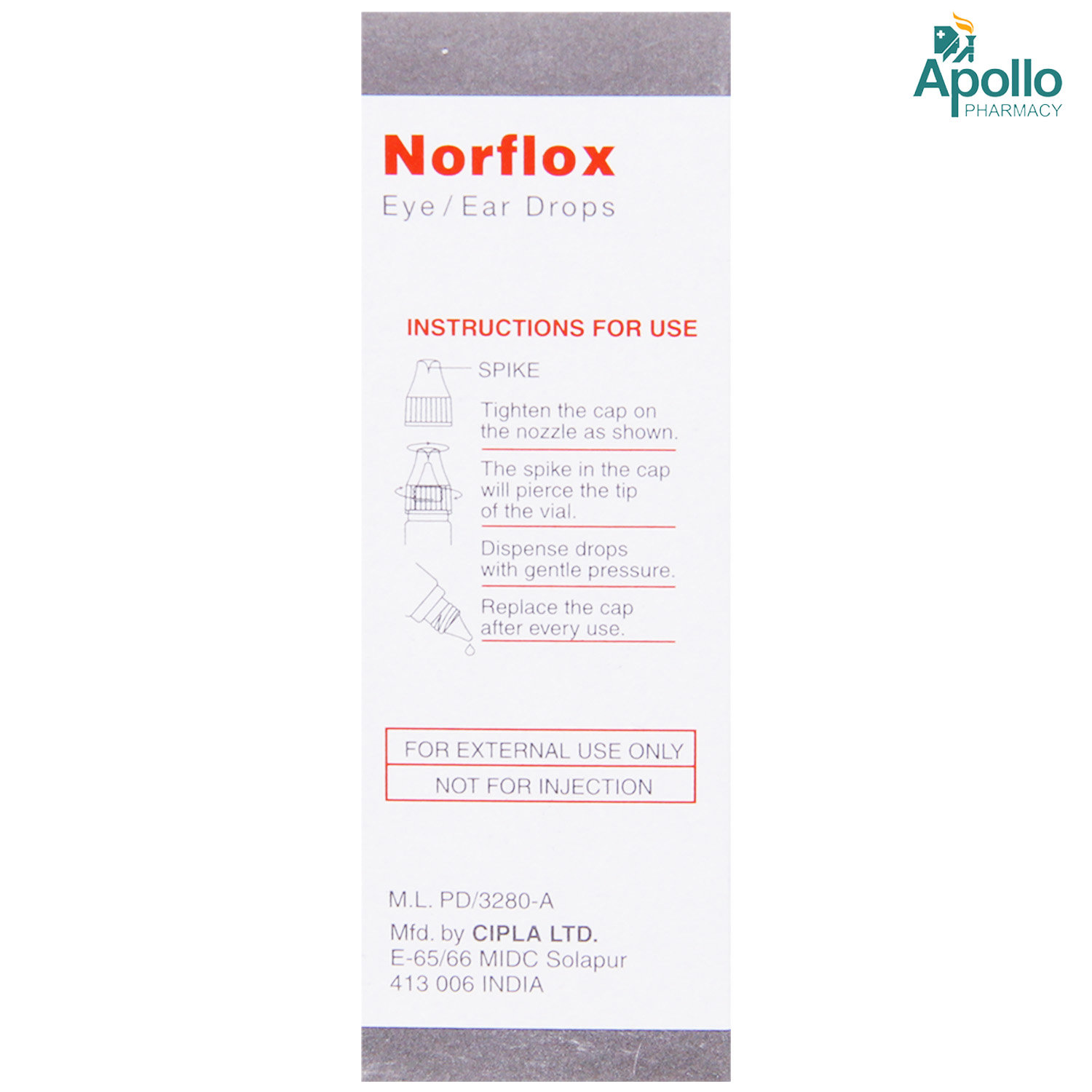Norflox Eye/Ear Drops 10 ml






MRP ₹16.5
(Inclusive of all Taxes)
₹2.5 Cashback (15%)
Selected Pack Size:10 ml
10 ml ₹14.9
(₹1.49 / 1 ml)
In Stock
5 ml ₹14.9
(₹2.98 / 1 ml)
In Stock
Provide Delivery Location
Online payment accepted
 Prescription drug
Prescription drugWhats That
Composition :
Manufacturer/Marketer :
Consume Type :
Return Policy :
Expires on or after :
About Norflox Eye/Ear Drops
Norflox Eye/Ear Drops belongs to a group of medicines called antibiotics used to treat bacterial eye and ear infections. An ear infection occurs when the bacteria affect the middle or outer ear, leading to pain and inflammation. Bacterial eye infection occurs when harmful bacteria invade any part of the eye, such as the eyeball, conjunctiva, or cornea.
Norflox Eye/Ear Drops contains Norfloxacin, which works by inhibiting DNA-gyrase, an essential enzyme involved in DNA replication. Thus, it kills bacteria and treats bacterial eye/ear infections.
In some cases, Norflox Eye/Ear Drops may cause side effects, such as discomfort and local burning sensation. Most of these side effects do not require medical attention and will resolve gradually over time. However, you are advised to talk to your doctor if you experience these side effects persistently.
Consult your doctor before using Norflox Eye/Ear Drops if you are pregnant or breastfeeding. Norflox Eye/Ear Drops should be used in children only if prescribed by the doctor. Do not touch the tip of the dropper as it may contaminate the contents. Keep your doctor informed regarding your health condition and ongoing medications to prevent any side effects/interactions.
Uses of Norflox Eye/Ear Drops
Directions for Use
Medicinal Benefits
Norflox Eye/Ear Drops belongs to a group of medicines called fluoroquinolone antibiotics used to treat bacterial eye and ear infections. Norflox Eye/Ear Drops contains Norfloxacin, a broad-spectrum antibiotic that works by inhibiting DNA-gyrase, an essential enzyme involved in DNA replication. Thus, it kills bacteria and treats bacterial eye/ear infections.
Storage
Drug Warnings
Do not use Norflox Eye/Ear Drops if you are allergic to any of its components or if you have viral or fungal eye/ear infections. Inform your doctor if you have glaucoma, high blood pressure, ocular hypertension, diabetes, eye/ear infection or injury, or heart, kidney or liver problems. Consult your doctor before using Norflox Eye/Ear Drops if you are pregnant or breastfeeding. Norflox Eye/Ear Drops should be used in children only if prescribed by the doctor.
Drug-Drug Interactions
Drug-Drug Interactions
Login/Sign Up
Using Mesoridazine together with Norflox Eye/Ear Drops 10 ml can increase the risk of an irregular heart rhythm that may be serious.
How to manage the interaction:
Taking Mesoridazine with Norflox Eye/Ear Drops 10 ml is not recommended, please consult your doctor before taking it. You should seek immediate medical attention if you develop sudden dizziness, lightheadedness, fainting, shortness of breath, or heart palpitations. Do not stop using any medications without talking to a doctor.
Coadministration of Norflox Eye/Ear Drops 10 ml with Cisapride can increase the risk or severity of irregular heart rhythm.
How to manage the interaction:
Taking Norflox Eye/Ear Drops 10 ml with Cisapride together can result in an interaction, it can be taken if your doctor has advised it. However, contact a doctor immediately if you experience sudden dizziness, lightheadedness, fainting, shortness of breath, chest pain or tightness, rapid heartbeat, or memory loss. Do not discontinue any medications without consulting a doctor.
Coadministration of Norflox Eye/Ear Drops 10 ml with Sotalol can increase the risk or severity of irregular heart rhythm.
How to manage the interaction:
Taking Norflox Eye/Ear Drops 10 ml with Sotalol together is generally avoided as it can result in an interaction, it can be taken if a doctor has advised it. However, contact a doctor immediately if you experience sudden dizziness, lightheadedness, fainting, shortness of breath, chest pain or tightness, rapid heartbeat, or memory loss. Do not discontinue any medications without consulting a doctor.
The combination of Amiodarone and Norflox Eye/Ear Drops 10 ml may significantly raise the risk of an abnormal heart rhythm.
How to manage the interaction:
Despite the fact that Amiodarone and Norflox Eye/Ear Drops 10 ml interact, it can be taken if prescribed by a doctor. If you get dizziness, lightheadedness, fainting, or fast or racing heartbeats, consult a doctor. Do not stop taking any medications without visiting a doctor.
Coadministration of Norflox Eye/Ear Drops 10 ml with Disopyramide can increase the risk of irregular heart rhythm.
How to manage the interaction:
Taking Norflox Eye/Ear Drops 10 ml with Disopyramide together can result in an interaction, it can be taken if your doctor has advised it. However, contact a doctor immediately if you experience sudden dizziness, lightheadedness, fainting, shortness of breath, chest pain or tightness, rapid heartbeat, or memory loss. Do not discontinue any medications without consulting a doctor.
Using bepridil together with Norflox Eye/Ear Drops 10 ml can increase the risk of an irregular heart rhythm that may be serious.
How to manage the interaction:
Taking Norflox Eye/Ear Drops 10 ml with Bepridil is not recommended, please consult your doctor before taking it. You should seek immediate medical attention if you develop sudden dizziness, lightheadedness, fainting, or a fast or pounding heartbeat. Do not stop using any medications without talking to a doctor.
Coadministration of Norflox Eye/Ear Drops 10 ml with Vandetanib can increase the risk or severity of irregular heart rhythm.
How to manage the interaction:
Taking Norflox Eye/Ear Drops 10 ml with Vandetanib together can result in an interaction, it can be taken if your doctor has advised it. However, contact a doctor immediately if you experience sudden dizziness, lightheadedness, fainting, shortness of breath, chest pain or tightness, rapid heartbeat, or memory loss. Do not discontinue any medications without consulting a doctor.
Using toremifene together with Norflox Eye/Ear Drops 10 ml can increase the risk of an irregular heart rhythm that may be serious.
How to manage the interaction:
Co-administration of Norflox Eye/Ear Drops 10 ml with Toremifene can result in an interaction, but it can be taken if your doctor has advised it. If you experience any symptoms like an irregular heartbeat, dizziness, fainting, or difficulty breathing, it is important to contact a doctor right away. Do not stop using any medications without a doctor's advice.
Aminolaevulinic acid sensitizes skin to bright lights and combining it with Norflox Eye/Ear Drops 10 ml may increase the risk of a severe photosensitivity (sunburn).
How to manage the interaction:
Although taking Norflox Eye/Ear Drops 10 ml and Aminolaevulinic acid together can cause an interaction, it can be taken if your doctor has suggested it. If you notice that your skin is very sensitive to sunlight or if you have a really bad sunburn, it's important to contact a doctor right away. Do not stop using any medications without talking to a doctor.
Coadministration of Norflox Eye/Ear Drops 10 ml with Efavirenz can increase the risk or severity of irregular heart rhythms.
How to manage the interaction:
Taking Norflox Eye/Ear Drops 10 ml with Efavirenz together can result in an interaction, it can be taken if your doctor has advised it. However, if you experience sudden dizziness, lightheadedness, fainting, shortness of breath, chest pain or tightness, rapid heartbeat, or memory loss, contact a doctor immediately. Do not discontinue any medications without consulting a doctor.
Drug-Food Interactions
Drug-Food Interactions
Login/Sign Up
Tofu Set With Calcium, Ragi, Seasame Seeds, Kale, Milk, Almonds, Bok Choy, Calcium-Fortified Soy Milk, Cheese, Yogurt, Cocoa, Coffee, Dark Chocolate, Energy Drinks With Caffeine, Green Tea, Kola Nut, Tea, Tiramisu
How to manage the interaction:
Consuming dairy products, cereal, or orange juice with Norflox Eye/Ear Drops 10 ml can interfere with its absorption and reduce its levels in the blood and urinary tract. Using caffeine together with Norflox Eye/Ear Drops 10 ml may increase the effects of caffeine. Norflox Eye/Ear Drops 10 ml dose should be taken at least one hour before or two hours after consuming dairy products, cereal, or orange juice. Avoid taking caffeine with Norflox Eye/Ear Drops 10 ml. Contact a doctor if you experience headaches, tremors, restlessness, nervousness, insomnia, and increased blood pressure or heart rate.
Diet & Lifestyle Advise
Eye infections:
- Wash your hands regularly. Avoid touching the eyes with dirty hands.
- Avoid rubbing the eyes.
- Avoid sharing eye makeup such as eyeliner, mascara or kohl.
- Always use clean towels or tissues to wipe your eyes and face.
- Regularly wash and change the pillowcases.
- If you wear contact lenses: Clean and replace contact lenses more often. Never share contact lenses. Always remember to wash your hands before inserting and after removing the contact lens.
Ear infections:
- Include fruits, vegetables, high-quality proteins and whole wheat grains in your diet to strengthen the immune system.
- Avoid consuming foods that you are allergic to as it can cause the body to produce excess mucus leading to inflammation.
- Avoid getting things like shampoo, soap, and water into the ear, as it can cause itching.
- Do not poke or scratch the ear, as it can cause damage to the ear canal, leading to inflammation.
- Avoid second-hand smoke.
- Stay healthy as immunity prevents infections.
Side Effects of Norflox Eye/Ear Drops
- Discomfort
- Burning sensation
Habit Forming
Therapeutic Class
Norflox Eye/Ear Drops Substitute

Product Substitutes
Author Details
We provide you with authentic, trustworthy and relevant information
Drug-Diseases Interactions
Drug-Diseases Interactions
Login/Sign Up
FAQs
Norflox Eye/Ear Drops works by inhibiting DNA-gyrase, an essential enzyme involved in DNA replication. Thus, it kills bacteria and treats bacterial eye/ear infections.
To treat your condition effectually, continue using Norflox Eye/Ear Drops for as long as your doctor has prescribed it to you. Consult the doctor if the irritation persists or worsens.
Norflox Eye/Ear Drops can be used with other eye/ear medications if prescribed by your doctor. However, you are advised to maintain a gap of 10-15minutes between using Norflox Eye/Ear Drops and other eye/ear medications.
Do not use Norflox Eye/Ear Drops for longer durations unless prescribed, as it may lead to other infections. Consult your doctor if your condition worsens or does not improve despite using Norflox Eye/Ear Drops for a week.
Norflox Eye/Ear Drops may cause a local burning sensation. It is not necessary for everyone using Norflox Eye/Ear Drops to experience this side effect. However, if the condition persists or worsens, consult your doctor.
Disease/Condition Glossary
Bacterial eye infections: Bacterial eye infection occurs when harmful bacteria invade any part of the eye, such as the eyeball, conjunctiva, or cornea. Symptoms of an infection include red eye, pain, discharge, watery/dry eyes, swelling, itching, and sensitivity to light. The common bacterial eye infections are conjunctivitis, stye, and keratitis. Conjunctivitis (pink eye) is the infection/inflammation of the conjunctiva (white part of the eye) and the inner eyelid. A stye is a bump on the eyelid or base of eyelashes. Keratitis is the inflammation of the cornea. It is a common problem in people who wear contact lenses.
Bacterial ear infections: An ear infection occurs when the bacteria affect the middle or outer ear, leading to pain and inflammation. An ear infection occurs when the Eustachian tubes (small tubes that run from each ear to the back of the throat) become blocked or swollen. Infection of the middle ear (air-filled space behind the eardrum) is known as otitis media, whereas the inflammation of the external/outer ear canal that runs from the eardrum to the outside of the head is known as otitis externa. Ear infections can be painful due to inflammation and fluid build-up. Symptoms include pain or discomfort inside the ear, pus or fluid-like drainage from the ear, feeling of pressure inside the ear, and loss of hearing.

Have a query?
Buy best Ear, Nose & Oropharynx products by
Entod Pharmaceuticals Ltd
Cipla Ltd
NuLife Pharmaceuticals
Nri Vision Care India Ltd
Lincoln Pharmaceuticals Ltd
Glenmark Pharmaceuticals Ltd
Macleods Pharmaceuticals Ltd
Pristine Pearl Pharma Pvt Ltd
Centaur Pharmaceuticals Pvt Ltd
Dr Reddy's Laboratories Ltd
Lupin Ltd
Zydus Healthcare Ltd
Indoco Remedies Ltd
Intas Pharmaceuticals Ltd
Mankind Pharma Pvt Ltd
GlaxoSmithKline Pharmaceuticals Ltd
Leeford Healthcare Ltd
Megma Healthcare Pvt Ltd
Sapient Laboratories Pvt Ltd
Sun Pharmaceutical Industries Ltd
Zuventus Healthcare Ltd
Zydus Cadila
Auskincare Formualation Pvt Ltd
Alkem Laboratories Ltd
Bell Pharma Pvt Ltd
Chethana Pharmaceuticals
Dwd Pharmaceuticals Ltd
German Remedies Ltd
Kaizen Drugs Pvt Ltd
Torque Pharmaceuticals Pvt Ltd
Vilco Laboratories Pvt Ltd
Avilius Neutracare
Biochem Pharmaceutical Industries Ltd
Blubell Pharma
Delcure Life Sciences Ltd
Eris Life Sciences Ltd
Kavach 9 Pharma & Research Pvt Ltd
Medishri Healthcare Pvt Ltd
NVK Pharma
Optho Remedies Pvt Ltd
Ordain Health Care Global Pvt Ltd
Respionix Healthcare Pvt Ltd
Troikaa Pharmaceuticals Ltd
Xseed Pharma
Abbott India Ltd
Atopic laboratories Pvt Ltd
Cadila Pharmaceuticals Ltd
Clyde Pharmaceutical Pvt Ltd
East India Pharmaceutical Works Ltd
FDC Ltd
Incus Pharmaceuticals Pvt Ltd
Meridian Enterprises Pvt Ltd
Micro Labs Ltd
Morepen Laboratories Ltd
Nextgen Healthcare
Novalab Healthcare Pvt Ltd
Ocuris Pharmaceuticals Pvt Ltd
Precept Pharma
Salvador Visiontech Pvt Ltd
Sunways (India) Pvt Ltd
Timon Pharmaceuticals Pvt Ltd
Unison Pharmaceuticals Pvt Ltd
Aar Ess Remedies Pvt Ltd
Adley Formulations
Ajanta Pharma Ltd
Alercon Pharma Pvt Ltd
Apex Laboratories Pvt Ltd
Aver Pharmaceuticals Pvt Ltd
BMW Pharmaco India Pvt Ltd
Bio Warriors Pharmaceucticals Pvt Ltd
Casca Remedies Pvt Ltd
Elan Pharma India Pvt Ltd
Elivia Life Sciences Pvt Ltd
Elkos Healthcare Pvt Ltd
Floreat Medica Pvt Ltd
Healthgate Pvt Ltd
Ikon Remedies Pvt Ltd
Ipca Laboratories Ltd
Koye Pharmaceuticals Pvt Ltd
Lividus Pharmaceuticals Pvt Ltd
Orn Remedies Pvt Ltd
Rosa Lifesciences
Siloam Pharmaceuticals Pvt Ltd
Sitnez Biocare Pvt Ltd
Srigan Anatto Care Pvt Ltd
Uniza Healthcare Llp
Vatican Life Sciences Pvt Ltd
Welgenic Pharma
Wellok Pharma
West Coast Pharmaceuticals Pvt Ltd
Win Medicare Ltd
Zee Laboratories Ltd
Abyss Pharma Pvt Ltd
Accent Pharmaceuticals & Diagnostics
Alembic Pharmaceuticals Ltd
Alencure Biotech Pvt Ltd
Austere
Bacans Biotech Pvt Ltd
Biopolis Life Sciences Pvt Ltd
Biosys Medisciences
Alcohol
Caution
It is not known whether Norflox Eye/Ear Drops interacts with alcohol. Please consult your doctor if you have any concerns.
Pregnancy
Caution
If you are pregnant, please consult your doctor before using Norflox Eye/Ear Drops; your doctor will prescribe only if the benefits outweigh the risks.
Breast Feeding
Caution
If you are breastfeeding, please consult your doctor before using Norflox Eye/Ear Drops; your doctor will decide whether Norflox Eye/Ear Drops can be used by breastfeeding mothers or not.
Driving
Caution
The effects of Norflox Eye/Ear Drops on the ability to drive or operate machinery are unknown. Drive or operate machinery only if you are alert.
Liver
Caution
Please consult your doctor if you have any concerns regarding the usage of Norflox Eye/Ear Drops in patients with liver impairment.
Kidney
Caution
Please consult your doctor if you have any concerns regarding the usage of Norflox Eye/Ear Drops in patients with kidney impairment.
Children
Caution
Norflox Eye/Ear Drops should be used in children only if prescribed by the doctor.




_0.jpg?tr=q-85)

